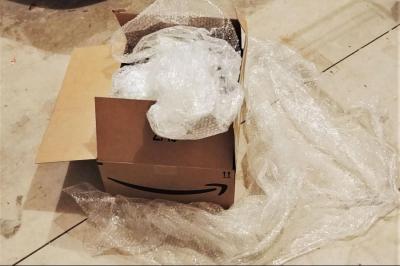Kyra Simone is a NOTL-born nature lover with a master’s degree in biology. In her spare time, she advocates for sustainable change, picks up garbage, makes recycled jewelry, and transforms furniture bound for the landfill.
Kyra Simone
Special to The Lake Report
We can all admit, 2020 was quite a year. Due to COVID-19 restrictions, we went out mostly for essentials and that will be the norm for the next month or more.
While online shopping helped us maintain our distance, shipping an increased number of parcels inevitably had an environmental impact. In 2021, we can resolve to reduce our purchasing footprint by better understanding the most wasteful aspects of online shopping.
Slow Down: Sometimes, buying items online has a lower impact than shopping at brick and mortar stores.
With standard shipping, as many parcels are delivered to an area as possible by optimizing routes, grouping orders into one parcel to each address and filling trucks completely. In this scenario, it makes sense that online orders produce fewer emissions than if every shopper had driven to a store for each purchase.
Unfortunately, rush shipping leaves efficiency on the doorstep, so to speak.
The same-day shipping offered by online retailers like Amazon has actually led customers to make more one-off, low-cost purchases, rather than bundling items to meet a threshold for shipping discounts. These small parcels, now all shipped individually, have an exponentially higher carbon footprint.
Rush shipping puts immense stress on delivery logistics. As a result, less-full trucks are deployed more frequently, and to customers that are more spread out.
Delivery drivers work under gruelling conditions, sometimes dropping off more than 250 packages per day. This affords only a few minutes per parcel and leaves little room for bathroom breaks or road safety.
It’s best to choose standard shipping, whenever possible. Choosing the faster option, even if it’s free, ultimately means the planet pays a price.
Point of No Return: Simple, free returns are another environmental pitfall of online shopping.
Knowing we can send back unwanted items makes us more likely to buy products we haven’t used. For example, we might purchase several clothing sizes to guarantee a proper fit.
While about one-tenth of purchases from physical stores are returned, this proportion can be up to 40 per cent for online orders.
Sadly, it is often difficult and expensive for returns to be processed and resold, even if they have never been used. For example, each clothing item must be inspected, pressed, sometimes cleaned and repackaged.
Most online returns are liquidated, shredded at recycling facilities, sent to landfill or incinerated. Some countries require e-retailers to recycle or donate unused products, but Canada does not yet have such legislation.
To avoid returning products, consumers can carefully review sizing information or contact sellers upfront for details. If items must be returned, they can sometimes be brought to the closest retail store instead of mailed.
Lots to Unpack: While the above aspects are large, systemic problems, conscious consumer choices can reduce the environmental impact of online purchases.
We can request that all items from an e-retailer be sent in one parcel to reduce packaging and emissions from multiple shipments. Even better, we can ask for plastic-free packaging.
Finally, delivery companies may make several trips if a recipient is not home. Opting to receive parcels at a nearby pickup point instead prevents the extra emissions from multiple delivery attempts.
This year, don’t forget to add green online shopping habits to your cart.










